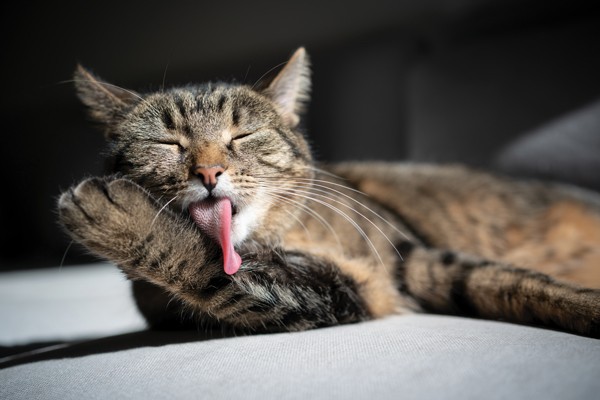Irritated or red eyes, pimples on the face, sneezing, runny nose or itchy throat… If these symptoms appear in the presence of a cat, it is a sign of an allergic reaction. Very common, cat allergy affects on average one in ten people. What exactly is it caused by? What solutions exist to prevent allergies and limit symptoms? Our advice.
Why are we allergic to cats?
Contrary to popular belief, a Cat Allergies is not caused by its hair, but by its saliva and sebum. Indeed, the salivary and sebaceous glands (skin glands) of the cat secrete an allergenic substance: the Fel d1 protein.
Thus, cat allergy is linked:
- in direct contact with the animal: its saliva, urine, tears, etc.;
- in indirect contact with the protein: this can be its hair (on which the allergenic substance is deposited during the toilet) and by extension all the objects in contact with your animal such as the carpet, bed, sofa, litter, etc. Upon contact with this protein, your immune system will secrete histamine. This is what will cause the unpleasant symptoms of cat allergy.
Did you know?
Since the production of the protein is stimulated by sex hormones, studies have shown that sterilized cats and neutered cats are less “allergenic” due to their low testosterone and progesterone levels.
What to do in case of cat allergy?
Here are the existing solutions to reduce the symptoms of cat allergy.
Limit the deposit of hair
To prevent Cat Allergies, you must start by minimizing contact with your cat’s hair. This involves brushing it regularly to remove dead hair, and vectors of allergens. Also, consider:
- regularly vacuum the floor, carpet, and rug;
- use an adhesive roller on sofa covers, cushions, clothing, and any textile that catches hair in general. Little tip: cover your furniture with easy-to-wash fabrics (towel or thin plaid) or choose a sofa with an easily removable cover;
- -prohibit your cat from sleeping on the bed or accessing your clothes closets.
Ensure good hygiene for your cat
Certain cleaning actions will help it stay clean and thus limit the risk of allergy. Even if your cat washes alone, certain areas need to be cleaned regularly, such as the eyes, the ears… and even the pads! To ensure their maintenance, gentle and suitable products exist, such as ear milk or eye cleanser.
Finally, do not forget to wash your hands after touching your companion, and be sure to change its litter daily. If possible, delegate this task and that of brushing, since urine and hair are major sources of allergens
Ventilate your interior daily
It may also be worth investing in an air purifier with a HEPA (High-Efficiency Particulate Air) filter.
Prevent allergies with medication
Antihistamines can help limit symptoms for a short time. Before taking any medicine, ask your pharmacist or doctor for advice.
Get desensitized
Desensitization, or immunotherapy, is a possible treatment for adults and children from 5 years old. It may help reduce symptoms related to cat allergy over the long term, but its effectiveness varies between individuals. His process: several extracts containing allergens are administered to you for several years (generally 3 to 5 years) so that your immune system gets used to the allergenic protein. To find out more, do not hesitate to consult an allergist: only he can assess the severity of the symptoms and advise you on the best treatment.
Cat allergy: symptoms, what to do?
Cat allergy is a common allergy that affects nearly 10% of the population. It is manifested by coughing, watery eyes, and sometimes small pimples. What to do? Take antihistamine drugs or part with your cat? Advice from Dr. Catherine Quequet, the allergist.
Symptoms
Allergy to cats is an immediate allergy: the symptoms, therefore, appear quickly, within minutes or a few hours following contact with the animal or with cat allergens deposited on clothing, for example. ” Indeed, the symptoms of cat allergy can occur in the absence of a cat in the presence of people who carry cat allergens on them,” explains Dr. Quequet, allergist.
Symptoms are essentially ENT and respiratory depending on sensitivity:
- rhinitis with sneezing,
- runny nose
- conjunctivitis,
- asthma attack,
Skin symptoms: outbreak of urticaria or worsening of atopic eczema.
The breed of the cat as well as its color and the length of its hair are not decisive. “ On the other hand, non-neutered male cats are more allergenic: their sebaceous and salivary glands secrete more Fel d 1, the main allergenic feline protein due to a higher testosterone level ” points out Dr. Quequet. Like all allergies, cat allergy can appear at any age – however, some people may be allergic to all cats except their own.
What to do?
First of all, we must already do tests to make sure that it is indeed a cat allergy, explains Dr If the allergy is proven, treatments exist:
Antihistamine drugs, nasal corticosteroids, and eye drop if the symptoms are minimal (rhinitis, conjunctivitis, etc.) Pulmonary function tests, background treatment, and bronchodilator in the event of an attack. If there are major crises, it is advisable to part with the cat, however, it takes 6 to 7 months for cat allergens to disappear from the house. Sublingual desensitization is also possible in adults as well as in children from 5 years old.
Preventing a Cat Allergy
Dr offers some tips for domestic hygiene:
- Use an air purifier with a HEPA (High-Efficiency Particulate Air) filter,
- Prefer a vacuum cleaner with a bag and HEPA filter
- Prefer smooth floors (parquet, tiles) to carpets and rugs
- Forbid the cat to come into the room and sleep on the bed,
- Wash the cat but the allergen level is only reduced for 24 hours




